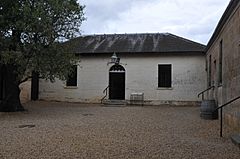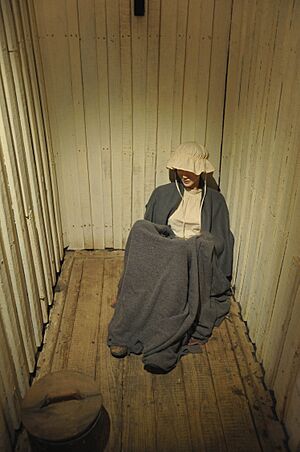Richmond Gaol facts for kids
 |
|
| Location | Richmond, Tasmania |
|---|---|
| Coordinates | 42°44′11″S 147°26′20″E / 42.7364°S 147.4389°E |
| Status | Historic Site |
| Security class | Maximum Security |
| Opened | 1825 |
| Closed | 1945 |
| Managed by | Tasmanian National Parks and Wildlife Service |
The Richmond Gaol is a very old prison in Richmond, Tasmania. It was built during the time when convicts were sent to Australia. Today, it's a popular tourist attraction and is the oldest prison still standing in Australia. Building the prison started in 1825. This was even before the famous Port Arthur prison colony was set up in 1833. One of the big jobs convicts held at Richmond Gaol did was building the Richmond Bridge.
Most of the prison buildings look just like they did when convicts lived there. You can see a special cell for women who were kept alone. This cell is about 2 meters long and 1 meter wide. The buildings also include sleeping rooms for chain gangs, a yard where whippings happened, a kitchen, and holding cells. Inside, you can find old items and papers from the past.
Contents
The Start of Richmond Gaol
People from Hobart Town started moving out to find more land for farming. The area of Sorell was already settled, and people were spreading into what became Richmond. During this time, convicts were forced to do hard labor. They built important things like roads, bridges, and public buildings.
Richmond officially became a town in 1824. A courthouse was built in 1825 for the local police. This courthouse was the very beginning of the prison building.
Growing the Prison: More Space Needed
By the 1830s, the prison was super crowded. It was only 19 square meters, so prisoners had to sleep in the hallways. To fix this, a new two-story building started construction in 1832 and was finished in 1833. The top floor was where the Gaoler (prison boss) lived. The bottom floor was used for storage.
In 1835, two new sections, called the Eastern and Western wings, were added. The Western Wing is still the entrance to the building today. These new sections helped keep male and female prisoners separate. The female wing also got a new kitchen and a bake oven.
To stop prisoners from escaping, a strong stone wall was built around the prison in 1840.
Closing Down and Becoming a Historic Site
By the mid-1850s, the prison was mostly used as a Watch House. This was because convicts were no longer being sent to Australia. In 1861, the local police took control. When the police moved to Hobart, the prison became just a group of holding cells.
By the end of the 1920s, the old prison was completely empty and forgotten.
In 1945, the prison was saved! It became a State Reserve. Later, in the 1970s, new laws put it under the care of the National Parks and Wildlife Service. This meant Richmond Gaol could be protected as an historic site.
Solitary Cells: Time Alone
The prison had special cells for solitary confinement. The idea was to place a prisoner in complete darkness and silence. This could last from 24 hours up to thirty days. The length of time depended on what the prisoner was accused of doing.
The Whipping Yard
No hangings ever happened at Richmond Gaol, but whippings did. Convicts would be tied to a wooden frame. Then, they would receive a certain number of lashes. In some places, a special belt was used to protect the kidneys. However, pictures from Richmond Gaol show this belt was not used there.
While some people in Hobart Town might get 500 lashes, the number was a bit lower in Richmond. It usually started at 25 lashes, sometimes going up to 75 or 100. After the whipping, salt was rubbed into the wounds. This sounds painful, but it was actually done to stop infection.
At Richmond Gaol, a medical officer was always present during whippings. They would check if the person's life was in danger. If someone was too weak to continue, they would be taken down. But once they were healthy enough, they would be brought back to finish their punishment.
Ghost Stories
Like many old places, Richmond Gaol has its own ghost stories. People say the third cell in the Men's Block is quite spooky. Visitors claim to hear moaning and deep sighs there. Some even say they feel a cold shiver when they get close to it.
See also
- Penal transportation


